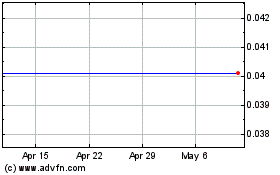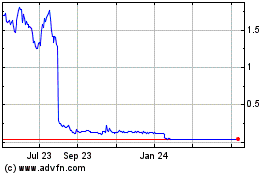Aravive Announces Positive Preliminary Data from Phase 1b Trial Evaluating Batiraxcept (AVB-500) in Combination with Cabozantinib for Treatment of Clear Cell Renal Cell Carcinoma
12 November 2021 - 11:00PM

Aravive, Inc. (Nasdaq: ARAV), a clinical-stage oncology company
developing transformative, targeted therapeutics to treat
life-threatening cancers, today announced positive new data from
the Phase 1b portion of its open-label Phase 1b/2 trial evaluating
batiraxcept (AVB-500) in combination with cabozantinib in patients
with clear cell renal cell carcinoma (ccRCC). A subset of these
data was included in a poster presentation at the Society for
Immunotherapy of Cancer’s (SITC) 36th Annual Meeting being held
November 10-14, 2021.
“We are encouraged by batiraxcept's early profile in patients
with clear cell renal cell carcinoma,” said Gail McIntyre, Ph.D.,
DABT, Chief Executive Officer of Aravive. “The current response
rate of batiraxcept in combination with cabozantinib is
encouraging. Cabozantinib alone produces response rates between
17-28% in a similar population. In heavily pretreated patients,
batiraxcept demonstrates clinical activity across the 15 mg/kg and
20 mg/kg doses with a tolerable safety profile. These results
reinforce our confidence in the potential of batiraxcept to improve
outcomes across multiple types of cancer by targeting the GAS6/AXL
signaling pathway. We look forward to initiating the Phase 2 trial
in the fourth quarter of 2021 and building on these promising
data.”
As of November 9, 2021, the safety, pharmacokinetics (PK), and
pharmacodynamics (PD) of batiraxcept 15 mg/kg and 20 mg/kg in
combination with cabozantinib in patients with 2L+ ccRCC have been
evaluated in 18 patients. Clinical activity across these two doses
has been evaluated in 16 patients.
Safety Data:
- Analysis of all safety data demonstrates that batiraxcept has
been well-tolerated with no dose-limiting toxicities.
- There have been no batiraxcept-related serious adverse events
reported to date.
- There were no batiraxcept-related Grade 4 or 5 adverse
events.
- 3 patients experienced Grade 3 adverse events considered by the
investigator as potentially being related to both batiraxcept and
cabozantinib.
- At the batiraxcept 15 mg/kg dose, 1 patient experienced
transient hypertension and 1 patient experienced transient
thrombocytopenia. Both events resolved while still receiving
batiraxcept.
- At the batiraxcept 20 mg/kg dose, 1 patient experienced a
thromboembolic event, small bowel obstruction, abdominal pain and
vomiting. The bowel obstruction, abdominal pain and vomiting
resolved while the patient continued batiraxcept treatment.
- All events are known adverse events associated with
cabozantinib use.
PK/PD Data:
- PK analyses indicate that batiraxcept trough levels were above
the minimally efficacious concentration (MEC) of 13.8 mg/L prior to
cycle 2 day 1 in the first 10 efficacy-evaluable patients.
Clinical Activity Data:
- Best overall response of partial response was observed in 7 of
16 (44%) evaluable patients across both dose levels. 9 of 16 (56%)
patients had a best overall response of stable disease. No patients
had progressive disease at their first radiological exam.
- 7 of 16 patients have had at least 16 weeks of follow up (at
least two post-baseline radiological exams). 5 of the 7 (71%)
patients have confirmed partial responses and 2 of the 7 (29%)
patients achieved confirmed stable disease.
- 88% (14/16) of patients had tumor decrease from baseline.
- 4 patients had 1 or more target lesions completely disappear. 3
patients were treated with batiraxcept 15 mg/kg and cabozantinib
and 1 patient was treated with batiraxcept 20 mg/kg and
cabozantinib.
- 2 patients had target lesions decrease from baseline by more
than 76%. 1 patient was treated with batiraxcept 15 mg/kg and 1
patient was treated with batiraxcept 20 mg/kg.
- This clinical activity was observed despite cabozantinib dose
reductions with median cabozantinib dose intensity of 41 mg (68% of
60 mg prescribed dose).
“The initial Phase 1b data of batiraxcept in combination with
cabozantinib are impressive and point toward the role of dual AXL
and VEGF inhibition in the treatment of clear cell renal cell
carcinoma,” said Eric Jonasch, M.D., Professor of Medicine, The
University of Texas MD Anderson Cancer Center. “These early signs
of clinical activity coupled with a manageable safety profile
introduce a potential new therapeutic approach for patients with
advanced kidney cancer.”
Poster Presentation Details
|
Title: |
A Phase 1b/2
randomized study of AVB-S6-500 in combination with cabozantinib
versus cabozantinib alone in patients with advanced clear cell
renal cell carcinoma who have received front-line treatment |
|
|
|
| Presenter: |
Reshma Rangwala, M.D., Ph.D., Chief Medical Officer of
Aravive |
| |
|
| Date: |
November 13, 2021 |
| |
|
| Time: |
7:00 a.m. – 8:30 p.m. ET |
| |
|
| Location: |
Hall E |
For additional information, please visit the SITC
36th Annual Meeting website:
https://www.sitcancer.org/2021/home.
Conference Call InformationAravive will host a
conference call and webcast today, November 12, 2021, at 8:30 a.m.
ET to discuss these clinical data. The conference call may be
accessed by dialing (877) 423-9813 (domestic) and (201) 689-8573
(international) and referring to conference ID 13724115. A webcast
of the conference call will be available in the Investors section
of the Aravive website at https://ir.aravive.com/. The archived
webcast will be available on Aravive’s website after the conference
call.
About the Batiraxcept (AVB-500) Phase 1b/2 ccRCC
TrialThe Phase 1b portion of the clinical trial is
expected to enroll approximately 25 patients in two dosing parts
(15 mg/kg and 20 mg/kg) to evaluate tolerability, PK, PD, and
clinical activity of batiraxcept in combination with cabozantinib.
The open-label Phase 2 portion of the clinical trial is expected to
enroll 55 patients across three parts. Part A is expected to enroll
approximately 25 patients and investigate batiraxcept 15 mg/kg in
combination with cabozantinib in 2L+ ccRCC patients. Part B is
expected to enroll approximately 20 patients and evaluate
batiraxcept 15 mg/kg in combination with nivolumab and cabozantinib
as a potential front-line treatment for ccRCC. Part C is expected
to evaluate batiraxcept 15 mg/kg monotherapy in approximately 10
patients with ccRCC who are not eligible for curative intent
therapies.
About Batiraxcept (AVB-500)Batiraxcept is a
therapeutic recombinant fusion protein that has been shown to
neutralize GAS6 activity by binding to GAS6 with very high affinity
in preclinical models. In doing so, batiraxcept selectively
inhibits the GAS6-AXL signaling pathway, which is upregulated in
multiple cancer types including ovarian, renal and pancreatic
cancer. In preclinical studies, GAS6-AXL inhibition has shown
anti-tumor activity in combination with a variety of anticancer
therapies, including radiation therapy, immuno-oncology agents, and
chemotherapeutic drugs that affect DNA replication and repair.
Increased expression of AXL and GAS6 in tumors has been correlated
with poor prognosis and decreased survival and has been implicated
in therapeutic resistance to conventional chemotherapeutics and
targeted therapies. Batiraxcept is currently being evaluated in
multiple clinical trials and has been granted Fast Track
designation by the U.S. Food and Drug Administration and orphan
drug designation by the European Commission in platinum resistant
recurrent ovarian cancer.
About AraviveAravive, Inc. is a
clinical-stage oncology company developing transformative, targeted
therapeutics to treat life-threatening cancers. The Company is
currently evaluating its lead therapeutic, batiraxcept (AVB-500),
in a registrational Phase 3 trial in platinum resistant ovarian
cancer, a Phase 1b/2 trial in second line plus, clear cell renal
cell carcinoma, and a Phase 1b/2 trial in first-line treatment of
pancreatic adenocarcinoma. The Company is based in Houston, Texas
and received a Product Development Award from the Cancer Prevention
& Research Institute of Texas (CPRIT) in 2016. For more
information, please visit www.aravive.com.
Forward-Looking StatementsThis communication
contains forward-looking statements within the meaning of the
Private Securities Litigation Reform Act of 1995. In some cases,
forward-looking statements can be identified by terminology such as
"may," "should," "potential," "continue," "expects," "anticipates,"
"intends," "plans," "believes," "estimates," and similar
expressions and includes statements regarding the potential of
batiraxcept (AVB-500) to improve outcomes for patients with
advanced kidney cancer and the expected enrollment in the Phase 1b
and Phase 2 trial portions of the ccRCC trial. Forward-looking
statements are based on current beliefs and assumptions, are not
guarantees of future performance and are subject to risks and
uncertainties that could cause actual results to differ materially
from those contained in any forward-looking statement as a result
of various factors, including, but not limited to, risks and
uncertainties related to: the potential of batiraxcept as a new
therapeutic approach for patients with advanced kidney cancer, the
data from patients treated in the future with batiraxcept being
consistent with the results reported, the ability to enroll the
expected number of patients, the impact of COVID-19 on the
Company's clinical strategy, clinical trials, supply chain and
fundraising, the Company's ability to expand development into
additional indications, the Company's dependence upon batiraxcept,
batiraxcept’s ability to have favorable results in clinical trials
and ISTs, the clinical trials of batiraxcept having results that
are as favorable as those of preclinical and clinical trials, the
ability to receive regulatory approval, potential delays in the
Company's clinical trials due to regulatory requirements or
difficulty identifying qualified investigators or enrolling
patients especially in light of the COVID-19 pandemic; the risk
that batiraxcept may cause serious side effects or have properties
that delay or prevent regulatory approval or limit its commercial
potential; the risk that the Company may encounter difficulties in
manufacturing batiraxcept; if batiraxcept is approved, risks
associated with its market acceptance, including pricing and
reimbursement; potential difficulties enforcing the Company's
intellectual property rights; the Company's reliance on its
licensor of intellectual property and financing needs. The
foregoing review of important factors that could cause actual
events to differ from expectations should not be construed as
exhaustive and should be read in conjunction with statements that
are included herein and elsewhere, including the risk factors
included in the Company's Annual Report on Form 10-K for the fiscal
year ended December 31, 2020, recent Current Reports on Form 8-K
and subsequent filings with the SEC. Except as required by
applicable law, the Company undertakes no obligation to revise or
update any forward-looking statement, or to make any other
forward-looking statements, whether as a result of new information,
future events or otherwise.
Contacts:
Media: Aulani Capuchin, Real Chemistry
acapuchin@realchemistry.com (559) 355-2673
Investors: Luke Heagle, Real Chemistrylheagle@realchemistry.com
(910) 619-5764
Aravive (NASDAQ:ARAV)
Historical Stock Chart
From Mar 2024 to Apr 2024

Aravive (NASDAQ:ARAV)
Historical Stock Chart
From Apr 2023 to Apr 2024
